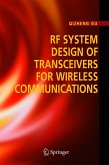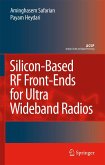This is the first book to describe most of the issues involved in the transition from a single standard to a Software Radio based wireless terminal. The book is both a technology tutorial for beginners as well as a starting point for technical professionals in the communication and IC design industry who are approaching the design of a Software Defined Radio. A complete overview of the actual state-of-art for reconfigurable transceivers is given in detail.
By the end of this decade, a 4G wireless terminal will be available that provides high quality multimedia, personalized services, and ubiquitous multi-standard broadband connectivity with a reasonable power consumption. In this context, a multi-band transceiver is needed that provides a high-level of programmability while keeping low design complexity and costs. Software Defined Radio (SDR) is the most promising technology to implement such a terminal as it enables multi-mode reception by tuning to any frequency band, by selecting any channel bandwidth, and by detecting any modulation.
Baseband Analog Circuits for Software Defined Radio aims to describe the transition towards a Software Radio from the analog design perspective. As the original idea of a "full-digital" Software Radio is far from the state-of-art, an analog front-end is still needed to achieve a feasible implementation. Most of the existent front-end architectures are explored from the flexibility point of view. A complete overview of the actual state-of-art for reconfigurable transceivers is given in detail, focusing on the challenges imposed by flexibility in analog design.
As far as the design of adaptive analog circuits is concerned, specifications like bandwidth, gain, noise, resolution and linearity should be programmable. The development of circuit topologies and architectures that can be easily reconfigured while providing a near optimal power/performance trade-offs is a key challenge. In this book, we tackle this challenge mainly for baseband analog circuits, i.e. amplifiers and filters, proposing efficient solutions that provide a high level of programmability. Measurements results validate the design strategies.
By the end of this decade, a 4G wireless terminal will be available that provides high quality multimedia, personalized services, and ubiquitous multi-standard broadband connectivity with a reasonable power consumption. In this context, a multi-band transceiver is needed that provides a high-level of programmability while keeping low design complexity and costs. Software Defined Radio (SDR) is the most promising technology to implement such a terminal as it enables multi-mode reception by tuning to any frequency band, by selecting any channel bandwidth, and by detecting any modulation.
Baseband Analog Circuits for Software Defined Radio aims to describe the transition towards a Software Radio from the analog design perspective. As the original idea of a "full-digital" Software Radio is far from the state-of-art, an analog front-end is still needed to achieve a feasible implementation. Most of the existent front-end architectures are explored from the flexibility point of view. A complete overview of the actual state-of-art for reconfigurable transceivers is given in detail, focusing on the challenges imposed by flexibility in analog design.
As far as the design of adaptive analog circuits is concerned, specifications like bandwidth, gain, noise, resolution and linearity should be programmable. The development of circuit topologies and architectures that can be easily reconfigured while providing a near optimal power/performance trade-offs is a key challenge. In this book, we tackle this challenge mainly for baseband analog circuits, i.e. amplifiers and filters, proposing efficient solutions that provide a high level of programmability. Measurements results validate the design strategies.








